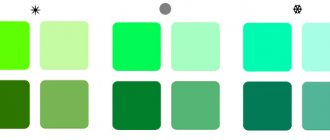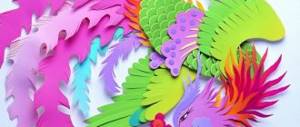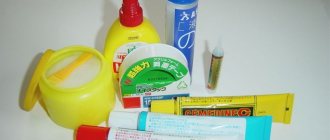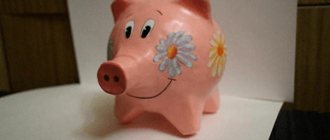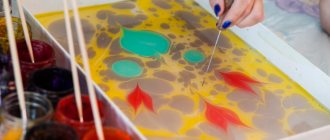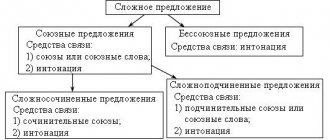Primary and additional colors in painting.
Primary colors (primary colors) are conditionally selected, “basic” colors, when mixed in different proportions, all other colors and shades can be obtained.
In painting: it is RED YELLOW BLUE.
It’s not for nothing that I stipulate what is used in painting, since printing and photography have their own set of primary colors.
If you mix red, blue and yellow color waves with each other, you get white.
These colors differ in lightness, in which brightness is at its peak. If you convert them to black and white format, you will clearly see the contrast.
_____________________________________________________________________________________________________
When mixing three primary colors together in pairs. We will get three more new colors.
RED+YELLOW=ORANGE YELLOW+BLUE=GREEN BLUE+RED=PURPLE
If the resulting paints are mixed with primary colors, the palette will increase by several more colors.
You can also introduce the concept of WARM COLDness; in short, we can say that each of the primary colors is divided into two more: cold and warm. As a result, by moving the first three (or more precisely 6) colors among themselves, we get a huge palette of colors, thanks to which we can paint a full-color picture.
_____________________________________________________________________________________________________
The concept and knowledge of primary colors is very important with the complementary term “complementary colors”.
By mixing the right pairs of complementary colors, we get a beautiful pearly gray color. And if there is an excess of any color in the picture, we can always “damp down” it with an additional color, or in the opposite situation, emphasize the color using its “color pair.”
In the last illustration, all the information discussed above is especially clearly visible.
In the center of the triangle are the three primary colors, the next edges are the colors that will be obtained by mixing the primary colors. On the outer circle (spectral), you can easily see pairs of complementary colors; they are located exactly opposite. In the case of primary colors, the tip of the primary triangle is located opposite one of the triangles formed by mixing primary colors.
Here are three basic complementary color pairs.
BLUE-ORANGE
RED GREEN
YELLOW-VIOLET
_____________________________________________________________________________________________________
This knowledge can be learned, remembered, written down. They are equally true not only for oil painting, but also for watercolor, tempera, etc.
I hope this information will be useful to someone.
Author: Shanko Irina
Plan - summary of an art lesson on the topic “Primary and composite colors. Mixing colors." (2nd grade)
Municipal budgetary educational institution
secondary school in the village of Kuzminskie Otverzhki
Lipetsk municipal district of Lipetsk region
“ Primary and composite colors. Mixing colors » .
prepared
teacher of fine art, drawing and art
Markina Galina Viktorovna
Lipetsk 2017
Lesson topic: “ Primary and composite colors. Mixing colors ."
Lesson objectives:
— Give an idea of the artist’s work with paints.
— Development of responsiveness to the beauty of nature.
— Awakening interest in fine arts.
Equipment:
white paper, gouache, brushes.
Visual range:
works by I. Levitan, A. Kuindzhi, Roerich, Van Gogh.
Literary series:
a fairy tale about magical colors.
Lesson progress:
1. Organizational moment.
2.
Post a new topic.
3.
Independent work.
4.
Summing up
Teacher. —
Do you guys know what we will be doing in our art lessons?
Students.
- Learn to draw!
Teacher. —
Of course, we will learn to draw and understand what we and artists draw. What do you think: can you be called artists? Of course, you and I are artists too. Every artist begins his work by preparing his workplace so that it is convenient for him to work, it is convenient for him to be creative. Which hand will we use?
Students.
- Right.
Teacher. —
This means the water is on the right to make it convenient to wash the brushes. We open jars of paint carefully so as not to get dirty. It is best to put the lids from the paints in the lid of the box, but the paints themselves are best left in the box. Guys, you need to treat paints with care, don’t get them dirty, and always cover them. Otherwise, the paints will take offense at you and will make ugly, dirty drawings for you. Our paints are different colors. Let's see what color paint we have and what we can paint with it. (Slide 2)
(Children's answers).
Teacher.
Do you want to see what artists depict with these paints? (Slides 3,4,5,6)
Each artist uses paint to show not only the beauty of nature, but also the mood.
Dear Guys! Today we will learn about the unusual properties of paints. It turns out that they differ from one another not only in color. Each of them evokes a certain mood in a person: peace, joy, fun, pain, indifference. To understand this better, listen to the story about colors.
“Once upon a time there was an artist. (Slide 7) One day, returning home from an evening walk, he met strange creatures. Outwardly, they resembled large ink blots, but they were living blots that could walk and talk. Posing as travelers, they asked for shelter for one night. The artist, being a kind and sympathetic person, of course, did not refuse. At home, by the light of an electric light bulb, he was able to see his guests better. There were four of them, and they differed not only in height, but also in color. The smallest, cheerful, playful, demanding constant attention blot was yellow. ( The other slide, a little larger, was orange. She also seemed cheerful, but behaved with dignity and in all her behavior resembled a first or second grade student. The two largest blots, the parents, were red and looked very energetic. (Slide 9) They were the ones They forced their children to do everything that they themselves did, while they themselves were always doing something, while maintaining a good mood and a healthy appearance.
(Slide 7) One day, returning home from an evening walk, he met strange creatures. Outwardly, they resembled large ink blots, but they were living blots that could walk and talk. Posing as travelers, they asked for shelter for one night. The artist, being a kind and sympathetic person, of course, did not refuse. At home, by the light of an electric light bulb, he was able to see his guests better. There were four of them, and they differed not only in height, but also in color. The smallest, cheerful, playful, demanding constant attention blot was yellow. ( The other slide, a little larger, was orange. She also seemed cheerful, but behaved with dignity and in all her behavior resembled a first or second grade student. The two largest blots, the parents, were red and looked very energetic. (Slide 9) They were the ones They forced their children to do everything that they themselves did, while they themselves were always doing something, while maintaining a good mood and a healthy appearance.
One of the blots held a large cage, in which, to the artist’s surprise, lay a fat green cat. It was clear from everything that he was well-fed, lazy and indifferent to everything. (Slide 10)
Over tea with apricot jam and oatmeal cookies, the guests told the host about themselves and their homeland - the Kingdom of Colorful Moods. (Slide 11) It turns out that the blots are designed in such a way that they change color depending on their mood, behavior and well-being.
Yellow is the color mainly of small children, cheerful playthings and clingy kids. Orange - cheerful schoolchildren, but not as mischievous as kids. Red is the color of adults, confident blots, active and healthy. (Slide 12) All diseased blots look purple. They often become very angry and aggressive. (Slide 13) Green is the color of indifference. But blue evokes peace, silence, and sleep. As you fall asleep, all the blots turn blue. (Slide 14)
The next morning, after breakfast, the overnight guests said goodbye to the good doctor, giving him glasses from the Kingdom of Colored Mood as a souvenir of themselves.
They, like blots, reacted to the state of everything that came into their field of vision, painting objects in the appropriate color, regardless of what they actually were.”
Imagine that you also have such glasses, and on the palette there are not six colors: yellow, orange, red, green, purple, blue, but six moods: joy, fun, hectic activity, pain, indifference, peace.
3. Practical work
. "PICTURE THE MOOD." (Slides 15-23)
If you don't have orange paint, mix red and yellow.
If you don’t have green, mix yellow and blue.
If you don’t have purple, mix blue and red.
(I show working techniques on the board).
Independent work (Slide 24)
4. Summing up.
Successful works are those that clearly show the emotional state of the child. Works are posted on the board.
Teacher.
Some artists, guys, paint their paintings in this manner. For example, artist V.V. Kandinsky and Leonid Afremov. Their paintings can easily be called “Mood Paintings”.
5. Repetition of the main points of the lesson.
What did you like most?
Which artists do you remember?
Did you like their work?
What mood do different colors evoke in you? Etc.
Materials used and Internet resources
- “The Tale of Blots” is the teacher’s own creation.
2. N.M. Sokolnikova. Art. 2nd grade. Textbook. — M.: AST, Astrel.
Video lesson: color wheel, additional colors in painting and the contrast between them, summary
1. In painting, blue, yellow and red are called primary colors, since by mixing other colors you cannot get them, but by mixing primary colors you can get the rest. 2. If you gradually mix a little bit of red into yellow, and place each slightly redder shade next to the previous batch, making a smooth transition from yellow to red, and then also mix blue with red and yellow with blue, you will get a color circle:
Color wheel and complementary colors on it
*Drawing it perfectly on a computer is quite problematic due to the fact that monitors cannot reproduce all colors. 3. Colors that are opposite on the color wheel are called complementary. Mixing them in the right proportions gives a gray color. 4. Our vision is designed in such a way that if the eye sees colors surrounded by some bright color, then vision gives these colors a shade complementary to the bright color (blue to colors against an orange background, etc.). Therefore, neutral gray surrounded by orange will appear blue to us.
*Some argue that the effect is more noticeable if you focus on one gray square and at the same time try to note for yourself what color your peripheral vision perceives the adjacent gray square (I don’t know how correct this is). Someone tries to see two gray squares at the same time and compare them. Someone, on the contrary, tries to cover all the other colored squares and observe the effect on only one.
5. If one complementary color lies next to another, then they give each other even more “strength” and create a particularly strong contrast.
Next lesson: how to use complementary colors in practice
To the list of lessons
Cool and warm colors
Each color "leans" towards one or the other. This is not always noticeable; sometimes the warmth or coolness of a color is barely noticeable. But cold ones should be distinguished from warm ones, since when mixed, these properties have a serious impact on the result.
Among the main ones, yellow and red are warm colors, and blue is cool colors. In addition, if you make comparisons among species of the same color, you may find that among the reds, yellows, and blues there are warmer and cooler shades. True, this is only appropriate within the framework of comparison: yellow will never be truly cold, but only colder than another yellow - otherwise it is no longer yellow, but some other color.
If you mentally move along the color wheel, you will see that each color has a relative “temperature”. When moving from the cold “pole” to the warm one, the “temperature” of the color increases, and when moving in the opposite direction – from warm to cold – this “temperature” drops.
The difference between warm and cool tones is very important to understand and grasp. Thanks to this knowledge, it will be possible to correctly convey the time of day - sunny day or bluish twilight, the desired mood and atmosphere - sad or joyful, etc. In addition, this will help the artist to competently play on the contrast of warm and cold, which also has a very impressive effect when used correctly. That's all for today, next time we will continue our conversation about color theory. Have fun with your painting!
beginning professionals
Three primary colors
The first thing you need to understand is that in painting there are only three colors that cannot be obtained by mixing others. These colors—yellow, red, and blue—are known as the primary colors. They form the middle (base) of the color wheel.
If you mix two primary colors, you get what is called a “complementary” (or secondary) color. Red and blue when mixed produce purple, red and yellow produce orange, and finally blue and yellow produce green. The specific shade of the complementary color depends on which yellow, blue and red you use and in what proportions you mix them. If you mix a primary color with a secondary color, you get a tertiary color.
Black and white also cannot be obtained by mixing, but they belong to the group of monochrome colors and do not participate in mixing chromatic colors.
Primary colors
So, there are three main colors in drawing: yellow, red and blue. Primary or primary colors are the basis of all colors. In order to get other colors or their shades, you need to mix the main ones. We will talk specifically about painting, since, obviously, printing and photography have their own set of primary colors.
The colors in the picture are different in lightness, in which the brightness is at its peak. If you convert them to black and white format, you will clearly see the contrast.
Pay attention to the wheel of primary and secondary colors. In the center of the triangle there are three primary ones. Facets are the colors that are obtained by mixing the main ones. On the outer circle you can easily see pairs of complementary colors; they are located exactly opposite. In the case of primary colors, the tip of the primary triangle is located opposite one of the triangles formed by mixing the primary colors.
